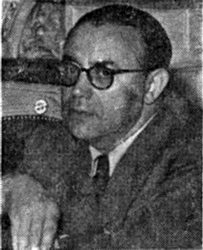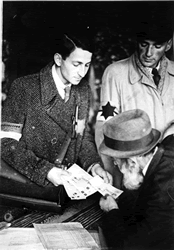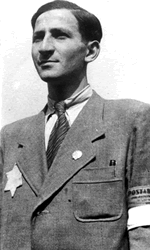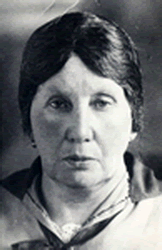Zonabend/Sonnabend Family
Click
on Photos to Enlarge
#zs-1
Ezekiel (Henry) Zonabend Sonnabend
Born in the town of Dobsin the Vistula River in Congress Poland, in Trs"a (23/07/1901).
His father Rafael and his mother Sarah Leah.
Learn the local Jewish high school and Olotzlbk, studied at Dresden, Heidelberg Engineering graduated and came
Nibrsitt Padua. Italy received the degree of Doctor and Professor of Social Sciences (Lsoziologih).
Emigrated to Rhodes and from there to Johannesburg, where he was a university lecturer on Soziologih and demography (1938-48).
He served during World War II with the rank of Major
#zs-2
#zs-3:
Nachman Zonabend, postal employee in the Lodz ghetto, paying money to the father of photographer Mendel Grosman at a post office branch in the ghetto. Photographed on June 10, 1941. The man standing on the left is wearing an armband with the Star of David symbol. The photograph was dedicated by Nachman Zonabend to his uncle Meir Rosenberg. Note: Yechiel Lewkowicz and Sawek - Yeshayahu Krotoszynski, survivors of the Lodz ghetto who had worked there as mail carriers, told that in 1941 - 1942, ... Nachman Zonabend was an inmate of the Lodz Ghetto from 1940 to 1945. In August 1944, following the liquidation of the ghetto, the Germans assigned him to a work unit whose task was to clean up the deserted ghetto. He succeeded in hiding parts of the ghetto archives, as well as photographs and art works of ghetto photographers and artists. He recovered these materials after the liberation of Lodz in January 1945. In 1947, Nachman Zonabend donated the bulk of his collection to the YIVO Archives. These are fragmentary records of the Eldest of the Jews of the Lodz Ghetto, by which name the Jewish ghetto administration was known. The ghetto was established by the Nazis on February 8, 1940, and Chaim Mordechai Rumkowski became its powerful Eldest of the Jews. He retained this office until the final liquidation of the ghetto and his own deportation to Auschwitz on August 29, 1944.
#zs-4:
Lodz, Poland, Zonabend wearing a postman's uniform in the ghetto.
#zs-5:
Yaakov Shabtai
#zs-6:
Avraham Shabtai (Zonabend) ?
Birth:
circa 1910
Rypin, Rypin County, Kuyavian-Pomeranian Voivodeship, Poland
Immediate Family:
Son of Yaakov ???? Sonnabend Shabtai ?????
Husband of Masha Shabtai
Father of Yaakov Shabtai; Dr Aharon Shabtai; <private> Shabtai and Yoel ???? Shabtai
Brother of Nachman Shabtai and ???? Zadok ??????? Zonabend Sonnabend
ai?Avraham and Masha Zonabend/ Shabtai with son Yaakov Shabtai Yaakov Shabtai (1934–81) (Hebrew: ???? ?????) was an Israeli novelist, playwright, and translator.
Biography[edit]
Shabtai was born in 1934 in Tel Aviv, Mandate Palestine. In 1957, after completing military service, he joined Kibbutz Merhavia, but returned to Tel Aviv in 1967.[1]
His best known work is Zikhron Devarim (1977), published in English in 1985 as Past Continuous. Written as a single paragraph, it was the first novel ever to be written in truly vernacular Hebrew. In its English translation the novel received international acclaim as a unique work of modernism, prompting critic Gabriel Josipovici of The Independent to name it the greatest novel of the decade, comparing it to Proust's In Search of Lost Time.
In Israel, Shabtai is also known as a playwright, having written such classics of the Israeli stage as Crowned Head and The Spotted Tiger. He also translated many plays into Hebrew, including works by Harold Pinter, Neil Simon, Noël Coward and Eugene O'Neill. Other works by Shabtai include Uncle Peretz Takes Off, a collection of short stories, andPast Perfect (Sof Davar), a continuation of Past Continuous in terms of narrative and style, published posthumously. In 2006 a collection of early stories was published under the title A Circus in Tel Aviv.
Shabtai died of a heart attack in 1981.
Shabtai's brother Aharon is a poet and a translator from Ancient Greek.
Awards and honours[edit]
• In 1978, Shabtai was awarded the Bernstein Prize (original Hebrew novel category), which was the inaugural year of the prize.[1]
• In 1978, he was awarded the Kinor David Prize for Plays.[1]
• In 1982, he was posthumously awarded the Agnon Prize for literature.[1]
• In 1999, the Tel Aviv Municipality named a street after him.
Published works[edit]
Works Translated into English[edit]
• Past Continuous (Zikhron Devarim, He: ????? ?????) Jewish Publication Society of America, 1985, ISBN 0-8276-0239-1
• Past Perfect (Sof Davar, He: ??? ???) Viking Press, 1987, ISBN 0-670-81308-7
• Uncle Peretz Takes Off (Ha-Dod Peretz Mamree, He: ???? ??? ?????) Overlook, 2004, ISBN 1-58567-340-4
Other Works[edit]
• The Wondrous Journey of the Toad (Ha-Masah Ha-Muflah Shel Ha-Karpad, He: ???? ?????? ?? ?????; Children's book), 1964.
• Poems and Ballads (Shirei Ha-Zemer), 1992.
• The Spotted Tiger and Other Plays (Namer Havarburot Ve-Aherim), 1995.
• Crowned Head and Other Plays (Keter Ba-Rosh Ve-Aherim), 1995.
• A Circus in Tel Aviv (Kirkas be-Tel Aviv, short stories, some alternate versions of stories from Uncle Peretz Takes Off), 2006.
References[edit]
1. ^ Jump up to:a b c d Shabtai, Yaakov – Jewish Writers of the Twentieth Century Bookrags, accessed July 14, 2011
External links[edit]
• Yaakov Shabtai at the Institute for the Translation of Hebrew Literature
•
#zs-7:
#zs-8
#zs-9
#zs-10
#zs-11
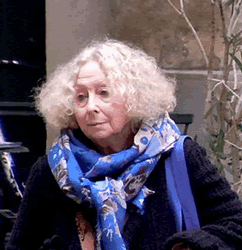
#zs-11
Françoise Zonabend
Arles, le 1er décembre 2011
Naissance
26 février 1935 (80 ans)
Paris
Nationalité
? France
École/tradition
Structuralisme - Européanisme
Principaux intérêts
Mémoire - Parenté - Généalogies - Ethnologie du risque - Archives de l'anthropologie - Anthropologie et littérature
Idées remarquables
Mémoire généalogique - Renchaînements d'alliance - Restitution ethnographique
Œuvres principales
La Mémoire longue, La Presqu'île au nucléaire, Une campagne voisine
Influencée par
Claude Lévi-Strauss
modifier - modifier le code - modifier Wikidata
?
Françoise Zonabend est une ethnologue et anthropologue française, née à Paris en 1935, ancienne directrice d'études à l'École des hautes études en sciences sociales (Paris) où elle a enseigné l'anthropologie de la France.
Biographie[
Après des études d'ethnologie et de sociologie en Sorbonne et effectué des recherches de terrain au Sénégal, elle soutient une thèse de IIIe cycle dirigée par Paul Mercier et intitulée Les Lycéens de Dakar.
En 1962, elle entre à l'École des hautes études en sciences sociales, aux fins de collaborer avec Isac Chiva à la rédaction de la revue Études rurales, publiée par le Laboratoire d'anthropologie sociale (LAS), institution fondée et dirigée par Claude Lévi-Strauss en 1960. C'est dans ce cadre institutionnel et scientifique – l'EHESS et le LAS – qu'elle accomplira toute sa carrière, se spécialisant alors dans l'anthropologie de la France.
Entre 1968 et 1980, elle conduit, avec trois autres chercheuses, une étude sur le village de Minot, situé en Bourgogne du Nord1. Pour sa part, Françoise Zonabend y étudie plus particulièrement le rôle et la fonction de la parenté, ainsi que les représentations de l'histoire locale ou globale qui s'y perpétuent de génération en génération, soutenues par des formes de mémorisation spécifiques.
En 1985, elle ouvre un nouveau chantier à la Hague, pointe ouest de la presqu'île du Cotentin. Elle y poursuit des recherches sur la parenté et la mémoire, mais elle traque aussi, dans ce lieu dédié à l'industrie nucléaire, les stratégies défensives mises au point par les employés et les riverains pour travailler et vivre sans trop de souffrances auprès de ces établissements à haut risque. C'est tout un pan de ce champ nouveau qu'est l'anthropologie du risque qui se trouve, ici, exploré.
Françoise Zonabend s'est aussi intéressée à la fabrication de l'écriture ethnographique, ainsi qu'aux modes de constitution des archives des ethnologues et aux usages dont celles-ci peuvent faire l'objet.
Francoise Zonabend a succédé, en 1996, à Jean Jamin à la tête de la revue Gradhiva, revue d'histoire et d'archives de l'anthropologie, actuellement éditée par le musée du Quai Branly. Elle l'a dirigée jusqu'en 2006.
Bibliographie[modifier | modifier le code]
• La Mémoire longue, Paris, PUF, 1986 ; rééd. avec « La mémoire de la mémoire », postface à la 2e édition, Paris, Jean-Michel Place, 2000.
• (éd.), « Le texte ethnographique », dans Études rurales, 1985, no 97-98 (en collaboration avec Jean Jamin).
• « Du texte au prétexte », dans Études rurales, 1985, no 97-98.
• (éd.) Histoire de la famille, en collaboration avec A. Burguière, C. Klapisch & M. Segalen (éds.), Paris, Armand Colin, 1986, 2 vol. (traductions en italien, espagnol, anglais, chinois, allemand) ; nouvelle édition revue et corrigée dans la collection « Références » Hachette, 1992.
• « La parenté : Origines et méthodes, usages sociaux de la parenté », dans I. Chiva et U. Jeggle (éds), Ethnologie en miroir. La France et les pays de langue allemande, Paris, Éditions de la Maison des sciences de l'homme, 1987.
• La Presqu'île au nucléaire, Paris, Éditions Odile Jacob, 1989, 188 p.
• « Mes frères, mes époux. Fonctionnement de la parenté et figures de l'alliance en Basse-Normandie », dans Françoise Héritier-Augé & E. Copet-Rougier (éds.), Les Complexités de l'alliance. Systèmes complexes d'alliance matrimoniale, vol. II, Paris, Éditions des Archives contemporaines, 1991, p. 207-224.
• « Paysage au nucléaire », dans A. Roger (éd.), Maîtres et protecteurs de la nature, Éditions Champ-Vallon, 1991, p. 132-142.
• « Gestion de l'alliance, gestion du troupeau » dans Françoise Héritier et E. Copet-Rougier (éds), Les complexités de l'alliance, IV, Économie, politique et fondements symboliques, Paris, Éditions des Archives contemporaines, « Ordres sociaux », 1994.
• « De l'objet et de sa restitution en anthropologie », dans Gradhiva, 1994, no 16.
• « Le nucléaire au quotidien », dans Autrement, série « Mémoires », 1995, no 39.
• (éd.), « Nouville après Nouville », présentation de la nouvelle édition de l'ouvrage de L. Bernot et R. Blancart, Nouville, un village français, Paris, EAC, 1995.
• (éd.), « Naître en marge », dossier établi et présenté par F. Z., Gradhiva, 1996, no 19.
• « Les mal-morts », dans R. Frydman et M. Flis-Trèves (éds), Mourir avant de n'être, Paris, Éditions Odile Jacob, 1997.
• Le Fœtus, le nourrisson et la mort, en coll. avec C. Le Grand-Sébille et M.-F. Morel, Paris, l'Harmattan, 1998, 234 p.
• « La mort : le chagrin, le deuil », dans Catherine Le Grand-Sébille, Marie-France Morel et Françoise Zonabend (éds), Le foetus, le nourrisson la mort, Paris, l'Harmattan, 1998, p. 27-38.
• (éd.) La Fabrique des héros, en coll. avec Pierre Centlivres et Daniel Fabre, Paris, Éditions de la Maison des sciences de l'homme, 1999.
• « L'innommable et l'innommé », dans Jean-Claude Beaune (éd.), Le déchet, le rebus, le rien, Seyssel, Éditions Champ Vallon, 1999, p. 90-98.
• « Le « dit » et le « su » de l'inceste », dans J.-L. Jamard, E. Terray et M. Xanthakou (éds), En substances, textes pour Françoise Héritier, Paris, Fayard, 2000.
• « Les maîtres de parenté. Une femme de mémoire en Basse-Normandie », dans L'Homme, 2000, no 154-155, p. 505-524.
• (éd.), « Archivari : Archives et anthropologie », dans Gradhiva, en coll. avec Jean Jamin, 2001-2002, no 30-31.
• « Vaines archives », dans Gradhiva, 2001-2002, no 30-31.
• « La mise en manuels. Les outils pédagogiques de a parenté », dans Gradhiva, 2002, no 32.
• Mœurs normandes. Ethnologie du roman de Raoul Gain « À Chacun sa volupté », Paris, Christian Bourgois, 2003.
• « Familles et parenté en Basse Normandie », dans Les cahiers Goubervilliens, 2003, no 7.
• « L'archive dans tous ses états », dans Sociétés et représentations, 2005, no 7. Numéro spécial « Lieux d'archives ».
• « Adopter des sœurs. Construction de la parenté et mémoire des origines », dans L'Homme', 2007, no 183.
• (éd.), Le Laboratoire d'anthropologie sociale. Cinquante ans d'histoire, 1960-2010, Paris, Collège de France et Fondation Hugot, 2010
• « Retour sur archives, ou comment Minot s'est écrit », dans L'Homme, 2011, no 200.
